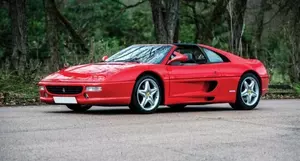
| Vehicle | Curb weight | Difference from world's smallest | Weight to power ratio | 0—60 mph acceleration ratio | Consumption ratio |
|---|---|---|---|---|---|
| F355 Spider |
1450 kg / 3197 lbs |
1025 kg (2260 lbs) heavier | 4 kg to 1 hp | 322 kg/s (710 lbs/s) | - |
| Vehicle | F355 Spider |
|---|---|
| Curb weight |
1450 kg / 3197 lbs |
| Difference from world's smallest | 1025 kg (1025 lbs) heavier |
| Weight to power ratio | 4 kg to 1 hp |
| 0—60 mph acceleration ratio | 322 kg/s (710 lbs/s) |
| Consumption ratio | - |

| Vehicle | Curb weight | Difference from world's smallest | Weight to power ratio | 0—60 mph acceleration ratio | Consumption ratio |
|---|---|---|---|---|---|
| 355 GTS |
1450 kg / 3197 lbs |
1025 kg (2260 lbs) heavier | 4 kg to 1 hp | 322 kg/s (710 lbs/s) | - |
| Vehicle | 355 GTS |
|---|---|
| Curb weight |
1450 kg / 3197 lbs |
| Difference from world's smallest | 1025 kg (1025 lbs) heavier |
| Weight to power ratio | 4 kg to 1 hp |
| 0—60 mph acceleration ratio | 322 kg/s (710 lbs/s) |
| Consumption ratio | - |

| Vehicle | Curb weight | Difference from world's smallest | Weight to power ratio | 0—60 mph acceleration ratio | Consumption ratio |
|---|---|---|---|---|---|
| 3.5 |
1450 kg / 3197 lbs |
1025 kg (2260 lbs) heavier | 4 kg to 1 hp | 322 kg/s (710 lbs/s) |
95 kg/L (209 lbs/L) |
| Vehicle | 3.5 |
|---|---|
| Curb weight |
1450 kg / 3197 lbs |
| Difference from world's smallest | 1025 kg (1025 lbs) heavier |
| Weight to power ratio | 4 kg to 1 hp |
| 0—60 mph acceleration ratio | 322 kg/s (710 lbs/s) |
| Consumption ratio |
95 kg/L (209 lbs/L) |